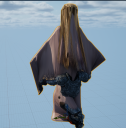High resolution character to UE
 Splatterbaby
Posts: 37
Splatterbaby
Posts: 37
Hi all. Is ther any way of sending a high resolution character to UE. Ive tried a million ways but nothing seems to work. OBJ seems to work but doesnt carry over the fine details of some morphs. ABC works but does not save the high res version of the character. FBX direct send explodes the character. All I want is an exact duplicate of my character inside UE. Ive also tried sending to maya and blender but the same occurs. Any help would be hugely appreciated. I dont care about materials those are easy to set up etc but the model with every little bit of detail Ive added is the big one.
Thanks:)


Screenshot 2022-04-24 140345.png
827 x 840 - 965K


Comments
There are no high-resolution characters, there are high-resolution morphs for the standard figures (which work by moving the virtual vertices created by the sub-division process). Does UE support SubD and multi-resolution morphs? it may as they are part of the Pixar OpenSubD system - if so you would need to aply SubD to the imported base in UE, then import the HD morph (probabyl from an unposed OBJ) using whatever route UE has - FBX does not, as far as I know, support this directly.
Hey thanks for this. Problem is If I use multple morphs Id have to select each and every one of them which is rather tedious. I found a bit of a workaround. I send the character to UE using bridge which always distorts the character so I use it only for sending materials. If you use alot of morphs to create a character then the bridge kinda becomes uselss. Then I send the high res to Zbrush and export the FBX from there.I have been trying to work a out a simple workflow the entire day, Im really close but zbrush flips the UV,s. Its been a problem since Zbrush started . Really annoying. Anyway then you need to take that FBX to maya flip the UV,s there and thats where I currently am. This seems to be the most efficient way so far as god knows Ive tried everythng including alot of what you described:) Complete nightmare but once I get this all going Ill set it up so its rather fast:)
Thanks for your input. I really appreciate it.
Ok this seemed to work and its pretty simple. Best part is you get exactly what u create. Meaning you can go wild in zbrush and upscale the res to what u want. Total control:) Crazy. the entire day working this out but it works and very well. here is a quick screen of the odel housing the correct geom, morphs and materials are all working, Flipped UV,s. Thanks for your help. Hugely appreciated:)
This way works well for stills. It can also be rigged up but thats another story I wish to stay clear for now:)
Now time for the hair... Wish me luck:)
I think I have an easier solution for you. What I do for HD morphs is, send over the Daz character at base resolution to Blender using Diffeomorphic. In the import dialogue you can choose to add JCMs, and then with your character in Blender, you can apply any other morphs you want. Now add a subdivision surface modifier to your character mesh. I've found a single subdivision is generally enough to smooth out any hard edges (around the ears for example), and you will get detail from any HD morphs as well. But the problem is you cannot apply modifiers to objects with shapekeys. Thankfully though there is actually an addon that will allow you to do just that. The way it works is, it runs through the list of all your morphs, subdivides each one, then replaces the current shapekey with the subdivided shapekey. This process can take quite awhile depending on how many morphs you have and the power of your CPU. For example, applying the subdivision modifier on a character with all JCMs, a bunch of body morphs and face morphs can take over 5 minutes. However, this saves you from having to manually apply the modifier for each shapekey, which would take even longer. Once the modifier is applied you can simply use the Blender to Unreal plugin (highly recommended) to send your character over.
The end result is a workflow that makes it easy to use HD morphs in Unreal, as well as a Blender file where you can create and maintain all of your morphs.
Hey thank you. This sounds actually really awesome. Then its all housed under blender and I can then still use sculpting etc. Ill give this a go. Im pretty uselss with using JCM,s though not even sure how to but Ill google it and see whhow to use them correctly to export. The problem is if there is a ton of morphs dont I have to add each and every one? Thanks again:)
Don't worry too much about the JCMs. They are totally optional but can help with animations where for example a shoulder/thigh bone is bent at high degrees. These work silently in the background in Daz, so you never interact with them. In Unreal, they work by assigning a post-process animation blueprint to your character. The blueprint is given a range of degrees for a specific bone, for example the thigh, and defines how much to kick in the corrective morph. A leg with no bend will not have any JCM applied. A leg with a high degree of bend will dial up the JCM to maximum.
The Bridge comes with this post-process animation blueprint setup already. When you send a Daz character over using the bridge, the blueprint is automatically assigned. When bringing it in from Blender, it is not automatically assigned, however it will still work just fine as the bones are the same regardless if bringing your character in from Daz or Blender. So all you need to do is open the bridge plugin folder in the content browser, right click the JCM blueprint and retarget to your character. Then open the character mesh and assign the blueprint in asset details. Again, totally optional, you do not need to do this.
As for whether or not you have to add every morph, that depends. Diffeomorphic gives you the option to automatically select from a list of various morphs. Generally when importing a character using Diffeomorphic I will check off the box to automatically add JCMs. From that point, I add all other morphs using the import .dbz morph option in Diffeomorphic. This means I create a scene file in Daz with the shape I would like, and export the .dbz file as well. This may seem manual and like it takes a long time, but the alternative is searching through a list of morphs in Diffeomorphic that give little indication as to what they do. Creating each morph I would like manually helps me keep track of all of my morphs easier. For example, if I want a morph to make the character curvy, rather than importing 10 different morphs with names like "Character Waist Circumference" and trying to dial them all in, I simply create a single "Curvy" morph in Daz and add it as a shapekey in Blender.
Hope that made sense. Happy to answer any other questions you may have.
Legend. Thank you:) Ill give this a try and thank you Ill come back here after a few days of trial and error and ask. THanks again this is golden. Didnt know about Diffeomorphic until today. Seems awesome.
Hey st3ph3nstrang3. Was wondering if there is a tutorial on this method from start to end. I can import my character but the clothes and hair dont come through. Only one way works . Import morphed characters one. All the other buttons or import ways dont work. So I can get the character in. Its low res. I can get the modifier working but I dont see details. I guess I need to import all the morphs etc. Still alot to discover with this way but I can see the potential:) Thanks again.
Unfortunately I have yet to see a tutorial using the Daz > Diffeomorphic > Unreal workflow. It's something I had to work out myself, but I had a natural transition from using Daz to using Blender and then deciding to experiment in real-time, so I was familiar with all the software used. There are tutorials on just Diffeomorphic though, this one is good. Diffeomorphic should send over any clothing that is attached to your character just fine. What you should have is:
-A Daz studio scene file with the character and clothing
-A .dbz file exported along with the scene file (this is used by Diffeomorphic)
It sounds like you may not have remembered to create the .dbz file, which must be done any time you want to import something into Diffeomorphic. This is just a script you run inside Daz that will create it for you. I went ahead and put the script on my toolbar, so it's right next to the rotate/translate tools on the toolbar in Daz for easy access.
If you aren't getting good results with your HD morphs with a single subdivision, consider subdividing again or even a third time. This will of course make your character ridiculously high-poly and not really suitable for real-time, but if you were doing cinematics or something like that it would be fine.
Hair works a little bit differently. You can import it the standard way, as you would clothing, but Unreal has a groom feature for hair that is quite nice and looks far superior to importing traditional mesh hair. You can find more info about that (and tutorials) here: https://www.daz3d.com/forums/discussion/489721/tutorial-daz-hair-to-unreal-grooming-system-via-blender-pit-stop
Ill test this out. Really appreciate your help and input. Hair im pretty waxed at. I use the blender hair plugin. Yes definately groom all the way. The power of putting it through blender is that I can repose and resculpt anything. Its like a non distructive workflow which is a MASSIVE win. Ill get this right as its definately the way forward with using unreal or rendering in Blender. Thanks again. Massive thanks and love for your help and response buddy.
Ok I used this tut (below is the link) and now I get HD characters in Blender:) Its a good step forward and easy to use. Still gotta work out clothes and props, hair etc but having rigged HD models is awesome. I didnt spend to much time on this but now that I have this part Ill get on to the next soon:)
Thanks again.